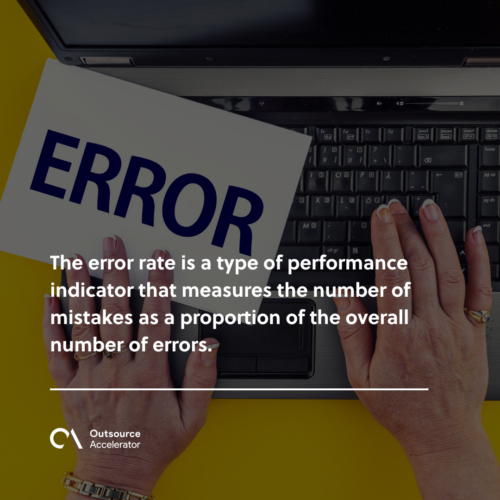Error rate
Definition
What is error rate?
Error rates are simply the frequency of errors that occurred. The word error rate can be used to describe anything that has the potential to cause errors.
The connection or data transfer will be less dependable as the error rate rises. The standard error rate formula is to get the total number of data units resulted in error, divided by the total number of unit data transmitted.
What is an acceptable error rate and why is it important?
In most firms, the error rate ranges between 10 and 30 errors per hundred opportunities. Failure rates of five to 10 out of every hundred opportunities are possible in well-managed organizations utilizing standard quality management practices.
The error rate might be a useful dependent variable. Effective data analysis requires the estimation and management of error rates.
The error rate is a type of performance indicator that measures the number of mistakes as a proportion of the overall number of errors. Monitoring the quality of services, systems, connections, and networks is useful in businesses.

Five common types of error rates
Here are the five example of error rates that you may encounter to your business:
Packet error rate
The packet error ratio (PER) is obtainable by dividing the number of incorrectly received data packets by the total number of received packets.
The packet per error has a quite strict rule, Iif at least one bit in a packet is wrong, the packet is considered incorrect.
Bit error rate
The bit error rate (BER) is defined as the rate with which mistakes occur in a transmission system. This can be easily converted into the number of errors that happen in a given number of bits.
The BER method is an excellent tool to evaluate the system’s performance. It’s useful when there’s a chance that data being transferred to a data link will introduce mistakes into the system.
BER is a critical measure in measuring the efficiency of data channels. The formula or bit error rate is simply getting the errors, divided by the total number of bits.
Word error rate
The word error rate (WER) is a popular measure of a speech recognition or machine translation system’s accuracy. It also assesses the performance of an automatic speech recognition system (ASR)
To get the word error rate, find the sum of substitution (replacing a word), insertions (inserting a word) and the deletions (omitting a word), then divide it by the number of words that were actually said.
The formula look like this:
WER = substitutions + insertions + deletions / number of words
Soft error rate
Soft error rates (SER) is the computation for soft error that typically occurs when a computing or electronic error causes wrong data.
Soft errors are induced by unpredictable radiation events that occur naturally in the terrestrial environment, influencing the data state of memory and sequential elements.







 Independent
Independent




